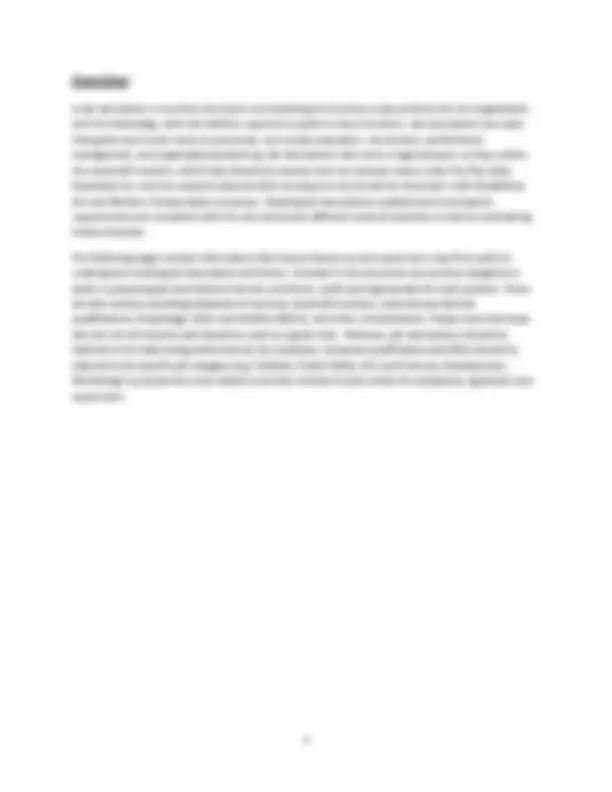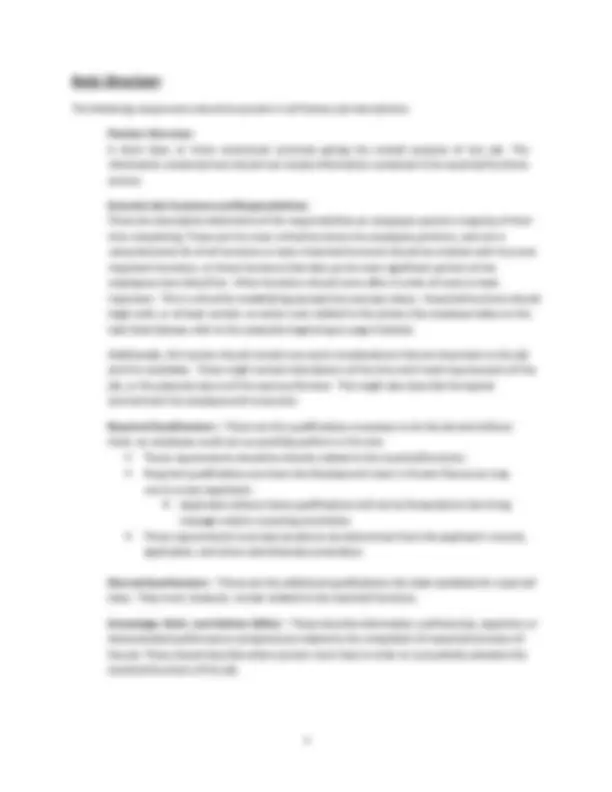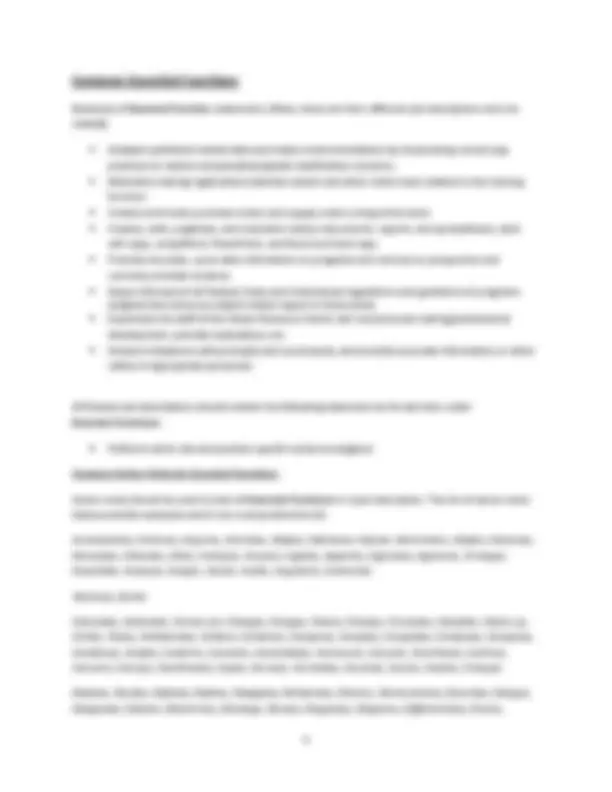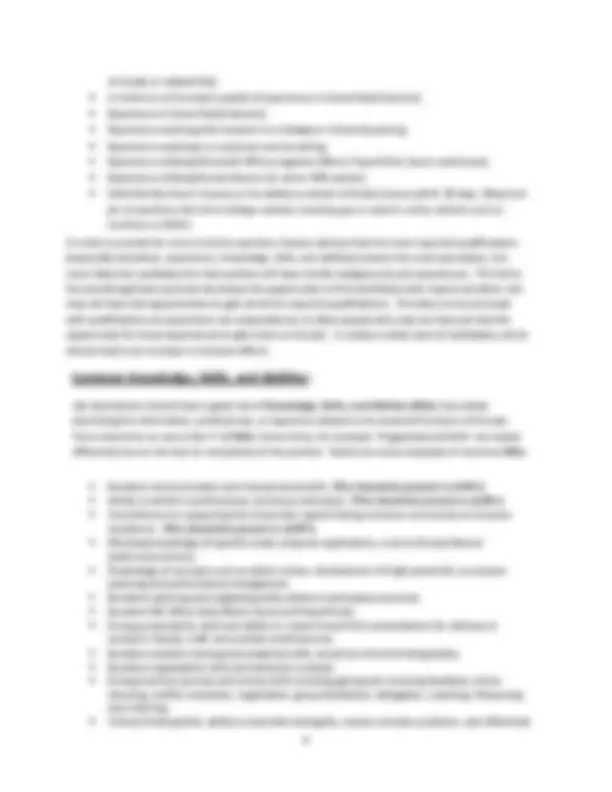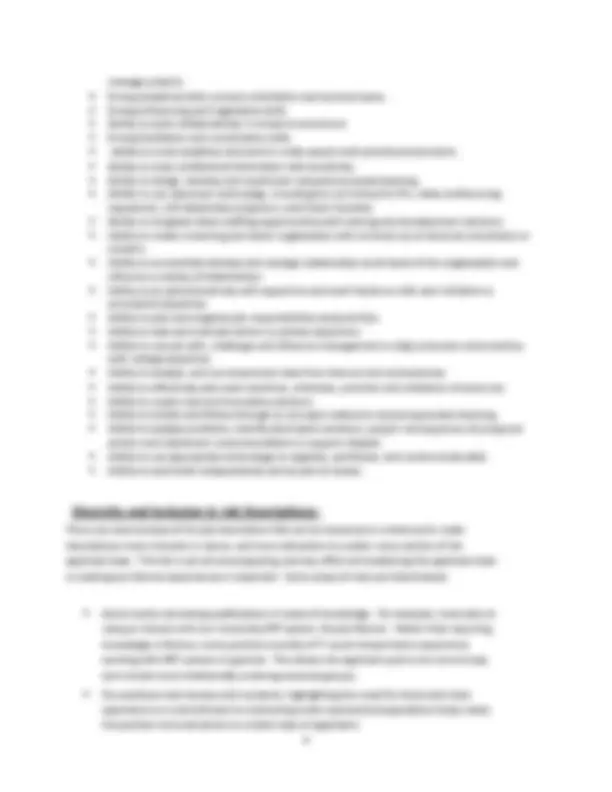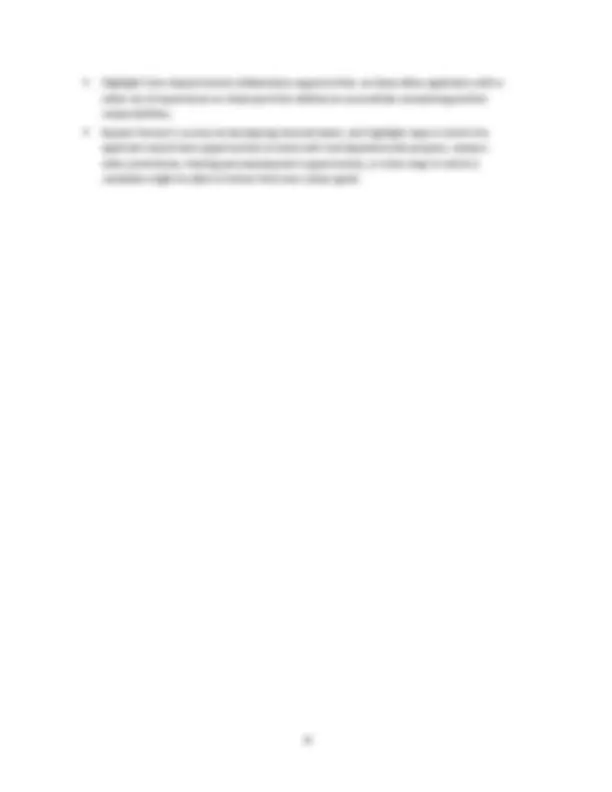Download Creating Effective Job Descriptions: A Guide for Stetson University and more Lecture notes Training and Development in PDF only on Docsity!
Supervisor’s Guide to Writing Job
Descriptions
For Stetson University
Table of Contents
- Overview:
- Basic Structure:
- Common Essential Functions
- Common Work Environment and Special Considerations:
- Common Required/Desired Qualifications:
- Common Knowledge, Skills, and Abilities:
- Diversity and Inclusion in Job Descriptions:..................................................................................................
Basic Structure :
The following components should be present in all Stetson job descriptions: Position Overview: A short (two or three sentences) summary giving the overall purpose of the job. The information contained here should not restate information contained in the essential functions section. Essential Job Functions and Responsibilities: These are descriptive statements of the responsibilities an employee spends a majority of their time completing. These are the most critical functions the employee performs, and not a comprehensive list of all functions or tasks. Essential functions should be ordered with the most important functions, or those functions that take up the most significant portion of the employees time listed first. Other functions should come after in order of most to least important. This is critical for establishing exempt/non-exempt status. Essential functions should begin with, or at least contain, an action verb related to the actions the employee takes on the task listed (please refer to the examples beginning on page 5 below). Additionally, this section should contain any work considerations that are important to the job and the candidate. These might contain descriptions of the time and travel requirements of the job, or the physical nature of the work performed. This might also describe the typical environment the employee will encounter. Required Qualifications – These are the qualifications necessary to do the job and without them, an employee could not successfully perform in the role.
- These requirements should be directly related to the essential functions.
- Required qualifications are items the Employment team in Human Resources may use to screen applicants. ➢ Applicants without these qualifications will not be forwarded to the hiring manager and/or screening committee.
- These requirements must also be able to be determined from the applicant’s resume, application, and other submitted documentation. Desired Qualifications – These are the additional qualifications the ideal candidate for a job will have. They must, however, remain related to the essential functions. Knowledge, Skills, and Abilities (KSAs) – These describe information, proficiencies, expertise, or demonstrated performance competencies related to the completion of essential functions of the job. These should describe what a person must have in order to successfully complete the essential functions of the job.
Common Essential Functions
Examples of Essential Function statements: (Note, these are from different job descriptions and not related)
- Analyzes published market data and makes recommendations by interpreting current pay practices to resolve compensation/grade classification concerns.
- Maintains training registration/calendar system and other online tools related to the training function.
- Creates and tracks purchase orders and supply orders using online tools.
- Creates, edits, organizes, and maintains various documents, reports, and spreadsheets, both soft copy, using Word, PowerPoint, and Excel and hard copy.
- Provides accurate, up-to-date information on programs and services to prospective and currently enrolled students.
- Keeps informed of all Federal, State and Institutional regulations and guidelines of programs assigned and serves as subject-matter expert in those areas.
- Supervises the staff of the Career Resource Center and recommends training/professional development, provides evaluations, etc.
- Answers telephone calls promptly and courteously, and provides accurate information or refers callers to appropriate personnel. All Stetson job descriptions should contain the following statement as the last item under Essential Functions :
- Performs other site and position specific duties as assigned. Common Action Verbs for Essential Functions : Action verbs should be used to start all Essential Functions in a job description. The list of action verbs below provides examples and is not a comprehensive list. Accomplishes, Achieves, Acquires, Activates, Adapts, Addresses, Adjusts, Administers, Adopts, Advances, Advocates, Allocates, Allots, Analyzes, Answers, Applies, Appoints, Appraises, Approves, Arranges, Assembles, Assesses, Assigns, Assists, Audits, Augments, Authorizes Balances, Builds Calculates, Calibrates, Carries out, Changes, Charges, Checks, Chooses, Circulates, Classifies, Cleans up, Climbs, Closes, Collaborates, Collects, Combines, Compares, Compiles, Completes, Composes, Computes, Condenses, Confers, Confirms, Connects, Consolidates, Constructs, Consults, Contributes, Controls, Converts, Conveys, Coordinates, Copies, Corrects, Correlates, Counsels, Counts, Creates, Critiques Debates, Decides, Defends, Defines, Delegates, Deliberates, Delivers, Demonstrates, Describes, Designs, Designates, Detects, Determines, Develops, Devises, Diagnoses, Diagrams, Differentiates, Directs,
Tabulates, Teaches, Tells, Tends, Tests, Traces, Trades, Trains, Transfers, Transforms, Translates, Transmits, Treats, Troubleshoots, Tutors Updates, Uses, Ushers Validates, Verifies Weighs, Writes
Common Work Environment and Special Considerations :
The following are a list of common workplace settings and environmental hazards. The applicable statements should be included in the essential functions section of the job description and be relevant to the essential functions of the job. Below are some examples of common items found in this section.
- Works in an office environment.
- Works in a classroom/lab setting.
- Works primarily outdoors and is exposed to sun and other weather conditions.
- May be required to travel to and from College campuses and other destinations.
- May be required to travel out of town on a periodic basis.
- May be required to work flexible hours, including nights and weekends.
- May work in confined or enclosed spaces.
- May work from settings such as ladders, lifts, scaffolding, or other situations requiring exposure to heights.
- May experience airborne dust and mold, common to a Library setting.
Common Required/Desired Qualifications :
Required Qualifications are the qualifications necessary to do the job and without them, an employee could not successfully perform in the role. Required Qualifications are items the Employment team in Human Resources uses to screen applicants. Applicants without these qualifications will not be forwarded to the hiring manager and/or screening committee. Desired Qualifications contain additional degree and / or experience that the ideal job candidate will have. This list is meant to be an example and is not a comprehensive list.
- Graduation from an accredited high school or possession of an acceptable equivalency diploma.
- Associate’s degree from a regionally or nationally accredited college or university in [insert field of study] or related field.
- Bachelor’s degree from a regionally or nationally accredited college or university in [insert field of study] or related field.
- Master’s degree from a regionally or nationally accredited college or university in [insert field of study] or related field.
- Doctorate degree from a regionally or nationally accredited college or university in [insert field
of study] or related field.
- A minimum of [number] year(s) of experience in [insert field/industry].
- Experience in [insert field/industry].
- Experience working with students in a College or University setting.
- Experience working in a customer service setting.
- Experience utilizing Microsoft Office programs (Word, PowerPoint, Excel, and Access).
- Experience utilizing Elucian Banner [or other HRIS system].
- Valid Florida driver’s license or the ability to obtain a Florida license within 30 days. ( Required for all positions that drive College vehicles including gas or electric utility vehicles such as Cushman or GEM. ) In order to provide for more inclusive searches, Stetson advises that the more required qualifications (especially education, experience, knowledge, skills, and abilities) placed into a job description, the more likely the candidates for that position will have similar backgrounds and experiences. This limits the overall applicant pool and decreases the opportunity to find candidates who may be excellent, but may not have had opportunities to gain all of the required qualifications. The idea is to be as broad with qualifications as supervisors can reasonably be, to allow people who may not have yet had the opportunity for those experiences to gain them on the job. It creates a wider pool of candidates, which should lead to an increase in inclusive efforts.
Common Knowledge, Skills, and Abilities :
Job descriptions should have a good mix of Knowledge, Skills, and Abilities (KSAs) accurately describing the information, proficiencies, or expertise related to the essential functions of the job. There should be no more than 7- 10 KSAs. Some items, for example “Organizational Skills” are stated differently due to the level or complexity of the position. Below are some examples of common KSAs.
- Excellent communication and interpersonal skills. (This should be present in all JD’s)
- Ability to exhibit a professional, courteous demeanor. (This should be present in all JD’s)
- Commitment to supporting the University’s goal of being a diverse community of inclusive excellence. ( This should be present in all JD’s )
- Working knowledge of [specific area] computer applications, such as Elucian Banner [add/revise others].
- Knowledge of concepts such as talent review, development of high potentials, succession planning and performance management.
- Excellent planning and organizing skills; ability to anticipate outcomes.
- Excellent MS Office skills (Word, Excel and PowerPoint).
- Strong presentation skills and ability to create PowerPoint presentations for delivery to students, faculty, staff, and outside constituencies.
- Excellent problem-solving and analytical skills, as well as critical thinking ability.
- Excellent organization skills and attention to detail.
- Strong business process and service skills including giving and receiving feedback, active listening, conflict resolution, negotiation, group facilitation, delegation, coaching, influencing and visioning.
- Critical thinking skills, ability to deal with ambiguity, resolve complex problems, and effectively
- Highlight inter-departmental collaboration opportunities, as these allow applicants with a wider set of experiences to showcase their abilities at successfully completing position responsibilities.
- Explain Stetson’s success at developing internal talent, and highlight ways in which the applicant would have opportunities to assist with interdepartmental projects, campus- wide committees, training and development opportunities, or other ways in which a candidate might be able to further their own career goals.

